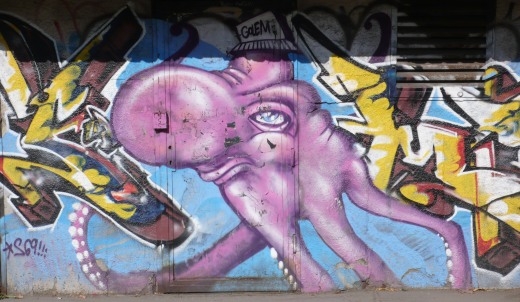
This addiction might be familiar to you. Photographing the ruins stirs up the treasure-hunter in me. I must go back, I must go back! I feel of having left there something. Yeah, like those beautiful little metal
doves, which decorated the window boxes! How nice it would be to save them. If I leave them there, they will go to the rubbish anyway, nobody will pick them out. They have almost no weight, it is not worth to dig for them, and it is so uncomfortable to take them off the external facade. True, it would not be easy to me either.
I can easily turn into the plot, no gates, no dogs, only the mud crumpled by the machinery.
I take some pictures, a gutted out dollhouse, green flowered plastic floor, a small table desperately holding the bricks which tumbled upon it, light falls on the abandoned mirror of the bathroom in the second floor, an upset morocco game, dust, dust. The outside corridor is still held by a couple of beautiful cast iron columns on the opposite side, too bad for them, they will also get spoiled, how good it would be to build a house.

A sharp whistle, well, that’s for me. And it is good that not for the dogs.
That I should get out of here, quickly, as this is a private property, say the three men coming.
The one even having a waist-belt is the security guard, the one even having no shirt is Lacika. Then we end up talking, even the pigeons come into play, actually they cannot help me, but I should come back in work time and speak with the representative of the builder, if it is important. So many people try to rake things out of here, perhaps I will also succeed. Meanwhile, I do not feel it so important any more, these few pictures will do, where could I take the metal doves. There’s not much wasted here, whatever can have a new host will have it, the best I can have from here are the pictures, I will not go into picking irons.
In the meantime the small, thin man says that he is the guard of the demolition at the other side of the street, if I want to take photos, he willingly lets me in. He is bringing the water in two plastic jugs, because in his place there is no running water any more. And one must wash himself with something.
He pulls aside the plank fence, we get in. The bike almost cannot stand in the two inch deep loose dust, well, most of the former building has been already cleaned off, some of it is still standing at the borders of the plot, it is the most difficult to demolish there. Laci says that they were left so for the time being out of fear that it would fall into the next courtyard, which belongs to another office building. And on the other side, along Váci út, because the traffic goes there.

And how many good used bricks are there. For example these with the inscription RKF. A huge amount of them. Sometimes people come and buy of them, to build them into the garage or the fence, for decoration. But there are a few ones that are really rare, for example this square one, with a Chinese symbol.
 The “Chinese symbol” – really beautiful. Do you know what it means?
The “Chinese symbol” – really beautiful. Do you know what it means?
But they have left so many things here, he says, even good furniture, tables, double beds. It will be not a few bucks to buy them again. You could also pull the wires from the walls. They could be recycled. True, one can no longer go up to the still standing part.
This is where he usually sleeps. What? In the front seat? Yes, across them. It is good soft. Here he has put that beautiful brick which he cannot find now, perhaps someone has thrown it out, it seems. Well, one can find all sorts of good things anyway.

























































 ddd
ddd









